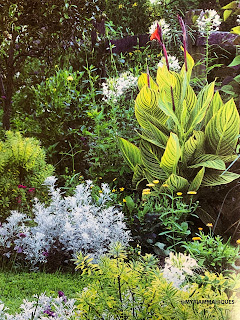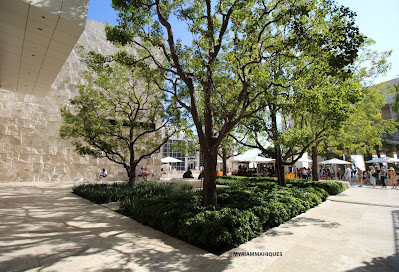The most important feature of a foliage
garden is the physical (somehow architectural) structure the leaves provide to
the garden.
Apart from the combination of different
types of leaves, the long lasting foliage goes well with wild grasses, lots of
ferns for shadowed areas, and a selection of deciduous to achieve different
characters along the seasons.
Depending on the location of big leaves
and small ones, an illusion of depth, or increased width can be created.
If the big leaves are at the front of the arrangement, we will have a
conceptual perspective that visually extends the limits.
Items to consider in a foliage garden:
How the plant will grow? Extended to the
sides, or up?
How big the leaves will be once the
plant is planted in the ground?
Do leaves cover the whole plant or just
part of it?
Is the scale of the plant selected good
for the garden?
Are we working with color combination?
(silver-gray, golden, green, purple, blueish, yellowish…)
How many different leaves shapes are we
combining?
Will the design be in repeating patterns
or in masses?
Will there be a dominant plant or tree?
There is a variety of shapes: swordlike,
rounded, heart shaped, detailed and intricate (like the Asparagus fern), lobed,
pointed, etc. It is important not to select lots of different shapes, but
repeat some patterns to create groups.
Textures varieties are smooth, shiny,
rough, corrugated, ribbed, leathery,…. The smooth shiny leaves are
the ones that reflect the sunlight more, but repel the rain. One of my
favorites is lamb’s ears, due to the color and because it keeps the drops of
rain and gives it a special brightness.
The plants overall form is the first
feature that captures our attention. Form is related to the foliage density and growth,
which gives structure. Seen from afar, the foliage may appear coarse, fine or
dense. The growth habits come in degrees; they could be upright, layered,
pyramidal, domed, mounded, fan-shaped, arching, weeping, bowl-shaped. The
combination of density and grow habit is the basis for the group morphology.
Dark colors behind yellow add depth and three dimension.
The distribution of leaves allows the
creation of boundaries or highlight certain areas. For example, more density at
the edges of a group, and sparse plants inside. Heavy bushes look better in
repeating patterns.
The Getty Center. Trees with green edges. Note the shadows of the trees on the light color floor. Photo by Myriam Mahiques, personal archives. 2018















No comments:
Post a Comment